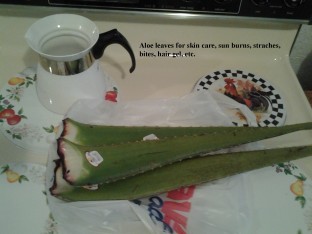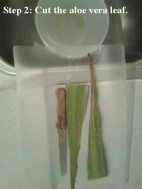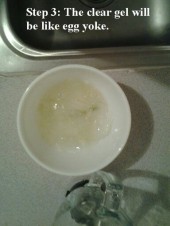It will cost about a dollar or less for the aloe vera leaves depending on your geographical location, and if your supermarket stocks these huge leaves since they might likely be considered a ‘specialty’ item and hard to find/ purchase. I know before we got a new grocery store, I had no idea aloe vera leaves were sold fresh much less grown for their edible purposes as well. In fact, I had never seen a large aloe vera leaf in person until I popped into the new grocer to see what all the hubbub was about. And what I found was some very new and somewhat exotic edibles such as aloe vera and cactus leaves (when boiled cactus leaves are very similar to green beans and freeze well, too) which I’ll blog about here in a little bit in a separate post.
Before I spent any money on the aloe vera leaves, I did my research. I scoured youtube to see what others had to say about fresh aloe vera leaves. It turns out I learned of the many benefits of aloe vera and cactus leaves. I had seen whole cactus leaves being sold at some other grocers between $5-7 dollars and you only received two small cactus leaves that you had to then go to the trouble to de-thorn, slice, chop—essentially ‘prep’ the old-fashioned way. I watched several youtube videos on how to cut up a cactus leaf and the thorns fly everywhere even when using a plastic bag and scrapping them with a paring knife. Sounded like a potential whacking off a digit accident waiting to happen.
I did more research late at night while waiting for my [then working] off-balance washing machine to finish thrashing another load of laundry. After watching about ten ‘how to’ cut aloe vera leaves and boil cactus leaves youtube videos I decided to give both the aloe vera and cactus leaves a try.
Are the aloe vera leaves edible? Yes, the gooey clear gel is edible. However, if the slime is yellow this will act as nature’s laxative and it’s highly recommended to discard the yellow stuff. In small quantities the aloe vera leaf gel can be blended into smoothies, chopped up and frozen for later use for skin application and/or used in DIY olive, coconut, and argan oil hair mask treatments. I even found a use for the aloe vera leaf itself and like to cut it up, bag, label and freeze them for later use when dry shaving my legs or whenever I might need something quick and handy for rubbing on my skin or through my hair to make it soft. I usually run on a very erratic schedule, so yes, there’s going to be prep work involved which should take about 30-35 minutes and you’ll have to set aside time to cut the aloe vera leaves. I find that I can make this aloe vera gel last me about a month (conserving it that is) and stretching it with some steam-treated distilled water. Never use city tap water as that can contain bacteria and other nasties that can’t be filtered out in a city water treatment facility try as they might, plus if the city fluoridates their water or its hard water that’s really yucky!
“Make sure it’s steam-treated [distilled water], not the other kind,” That was sound advice from my dear dad a year ago. He’s been a health nut long before I was ever born.
Here’s the steps I use for making my homemade aloe vera lotion. Oh, and this must be kept in the fridge or else it will go rancid if sitting out since there’s no preservatives whatsoever when I make my aloe vera lotion.

Step one: Wash the aloe vera leaf with some distilled water (never tap water) to give it a quick rinse. Drying the aloe vera leaf isn’t necessary unless you want to do this extra step.

Step two: Make sure you have a bowl or other container ready. I find that placing a bowl in the kitchen sink helps and I just scrape the gooey goodness into it from the cutting board. Use a serrated knife and a cutting board as well. Also, be extremely careful when slicing these aloe vera leaves. The gooey stuff is slimy and will be the consistency of egg yoke and it gets over everything and makes work surfaces and the knife you’re using very slippery. So, do exercise caution when cutting the aloe vera leaves with a sharp knife and take your time.

Step three: I like to cut off the tip and end and discard those in my compost container that I plan to empty into my garden. Next, I slice downward to remove the prickly thorny sides of the aloe vera leaf. Sometimes they’ll yield a very tiny amount of clear gooey stuff and I’ll cut those into slices and place them in my freezer bag for later use. When I can help it I don’t like to discard a lot of stuff until I get as much use from it as humanly possible.

Step four: Transfer the clear gooey stuff from the bowl and pour it into the blender. Blenders will vary and I like to start blending with the ice crushing option, then whip and puree. At this point the clear aloe vera gel should turn frothy and foamy. This is normal and the foam will settle. To make this stretch further I also pour in about half a cup of distilled water and blend it some more. Again, this will turn foamy and it will settle. I then make sure my aloe vera jar is handy and fill it. After screwing the cap on it I like to give the contents a good shake then place it in the fridge.
Shelf life of my homemade aloe vera lotion is about one week in the fridge. However, I’ve been able to make my aloe vera lotion last for about two weeks even a month if I’m conservative with it and haven’t noticed it going rancid in the fridge. And always whenever I remember I will pick up one or two aloe vera leaves and store them in my fridge until I need one this way I have a constant stock of them on hand. And look for the discounts. Sometime aloe vera leaves will be sold by the red tape bundle at a discount if they’re wilted. This I’ve discovered doesn’t matter much to me since I don’t use the wilted aloe vera leaves for smoothies. I use the wilted aloe vera leaves for my skin and hair care lotions. I use the good aloe vera leaves for the smoothies which I seldom make except once-in-a-while due to their cleansing/ detoxing properties.

Step five: pour the aloe vera lotion in a glass jar. I have heard that plastic containers can leach out chemicals into food and drinks so I re-use a 10 ounce glass green olive jar for my homemade aloe vera lotion (pictured).
Hope this how-to tutorial helps for my fresh homemade aloe vera lotion. I never use any preservatives when making this. When it settles it will feel like a raw egg when applying it to the hair and skin. But no need to panic, the skin absorbs the aloe vera gel rather fast and leaves your skin feeling velvety smooth. Sometimes there might be some gel sediment that adheres to the skin and hair. I use a soft-bristle natural foot brush to whisk this from my skin and hair. When applied to the hair (a little bit goes a long way), wrap your hair in a silk or cotton scarf or any soft large light-weight material will do and keep it on for an hour, then remove the scarf and gently comb your fingers through your dry hair. Doing this step after you’ve washed and towel-dried your hair works great and makes your hair feel extremely soft and gives it some shine. I found this to be a huge relief since my area is hard water. And since I quit exposing my hair to all the fluoridated city water recently, I noticed my hair is not as limp, weighed down, greasy or unhealthy or ‘unwashed’ in appearance. Also, I don’t wash my hair daily into overkill like I once used to do years ago and saturate my poor hair strands to chemically-laden shampoos and conditioners (whatever was cheap at one time). I also re-use my fresh fruit/ fresh veggie distilled rinse water and make my own Camomile sun tea on occasion to give some high lights to my hair. Other times I keep a large pickle jar in the fridge filled with part distilled and bottled drinking water (supposedly non-fluoridated when I checked).
DO NOT use a plastic comb to brush out your hair when applying this aloe vera gel into your hair. Sometimes it will leave microscopic gel balls that can tangle the hair, so go easy when brushing your hair. This hair care process shouldn’t be rushed as I found out in my early trial and errors.
Recently, I’ve heard from many folks that strive to grow out their hair and keep it healthy advise to ditch the plastic hair brushes and combs completely, and if at all possible, do not wash your hair with city water unless you have a water purifier/ filtration system that can filter out heavy metals, contaminants and some traces of fluoride. Another hair care top: opt for boar hair bristle hair brushes/combs. And those are difficult to find unless they’re antique. I saw a ‘made in China’ boar hair shower brush at Big Lots a while back, but inset in the middle of it was a chunk of plastic as a faux loofah sponge. I’ll pass thank you very much even though I realize getting rid of all plastics out of my life is nearly impossible although little by little I am making snail pace strides to natural vegan materials as I can afford to do so.
When I need to brush my hair I use an itty bitty antique celluloid comb. The rest of the time I use my antique hair/ clothing brushes since they were made during the 1850’s/ 1900’s and have real hair bristles (not nylon even though it was produced back in this time frame). Since using the antique hair/ clothing brushes to brush my hair vs. using plastic hair brushes has made a huge difference. I haven’t dealt with many tangles when brushing my hair after it’s completely dry, that is. And I haven’t felt any knots or painful tangles in my hair either like I used to get often when using a plastic brush and comb. And I quit combing my hair while its still wet. This is when the hair is most fragile and elastic-like. It can snap, strands can fall out (often referred to hair fall out) when brushed wet, tangle and knot like it’s nobody’s business, and did I mention all of it painful if you have a sensitive scalp? It is.
Thanks for re-blogging, liking, commenting, sharing, tweeting and especially to all of my subscribers. I truly appreciate your likes, shares, etc.! 🙂
I’ll be posting some budget gourmet kitchen how-to goodies from how to grow your own celery on your kitchen window sill, drying your own spices from fresh store-bought/ patio-grown herbs, making cinnamon-flavored toothpicks, and my almost “sugar free” dessert. 😀

You must be logged in to post a comment.